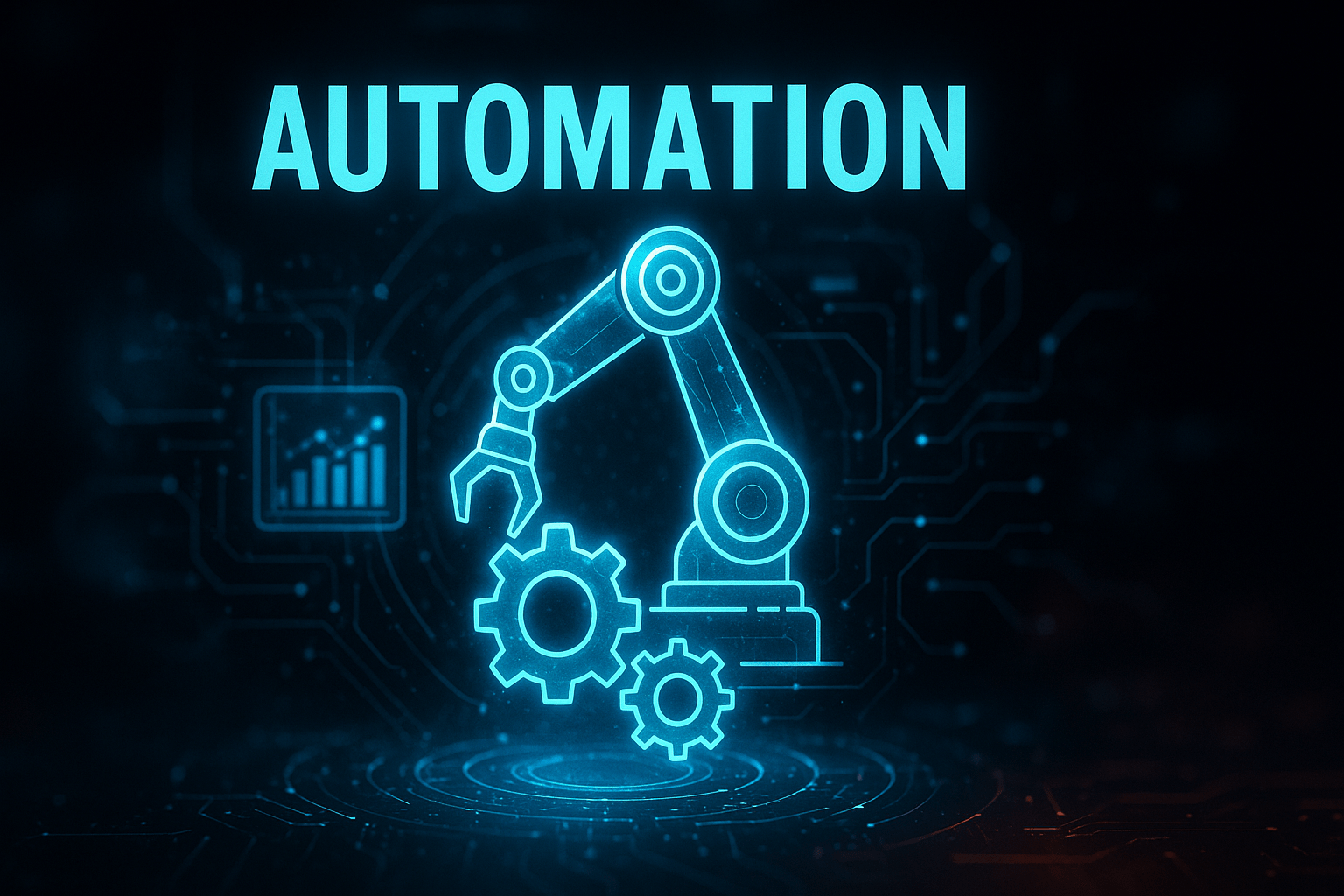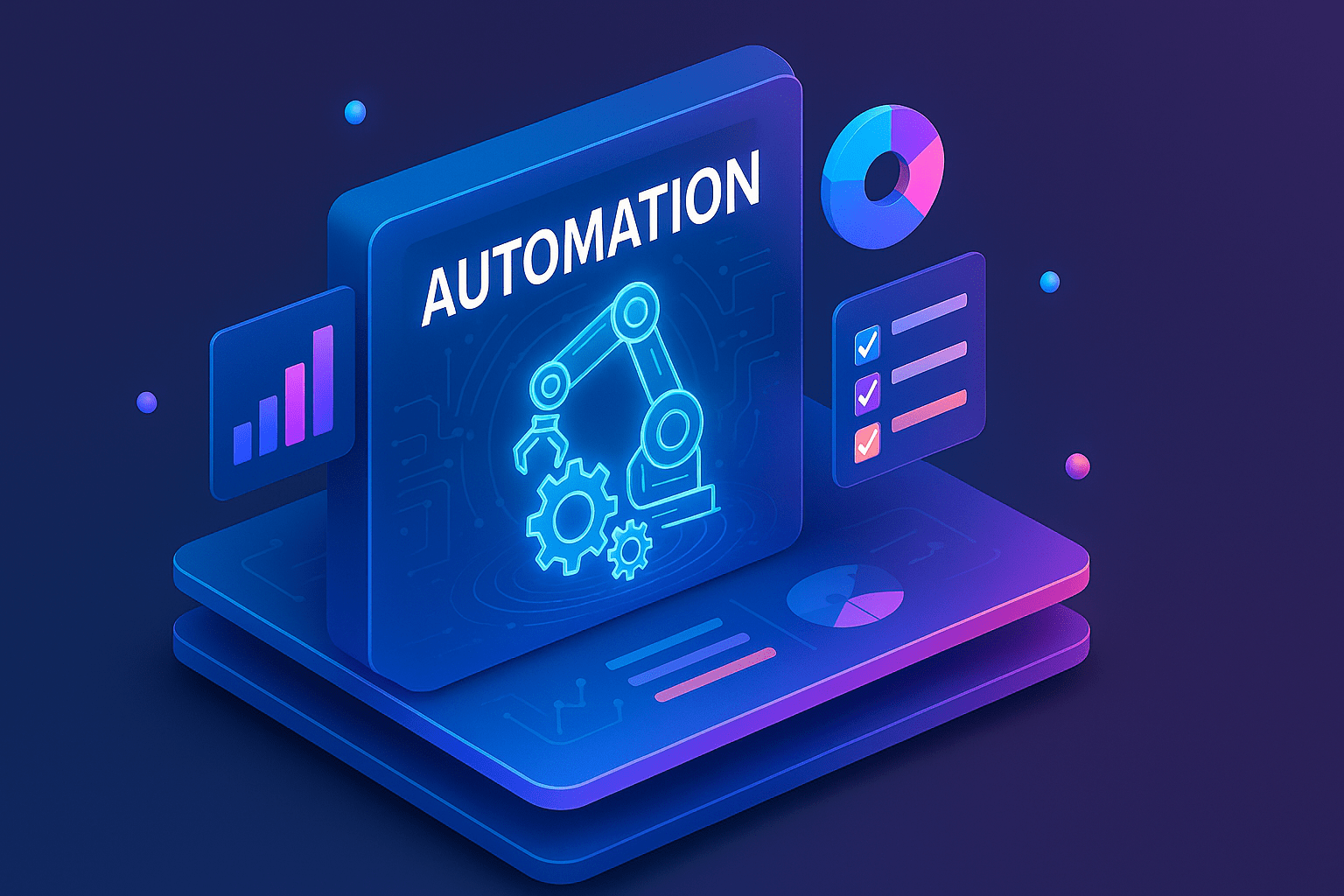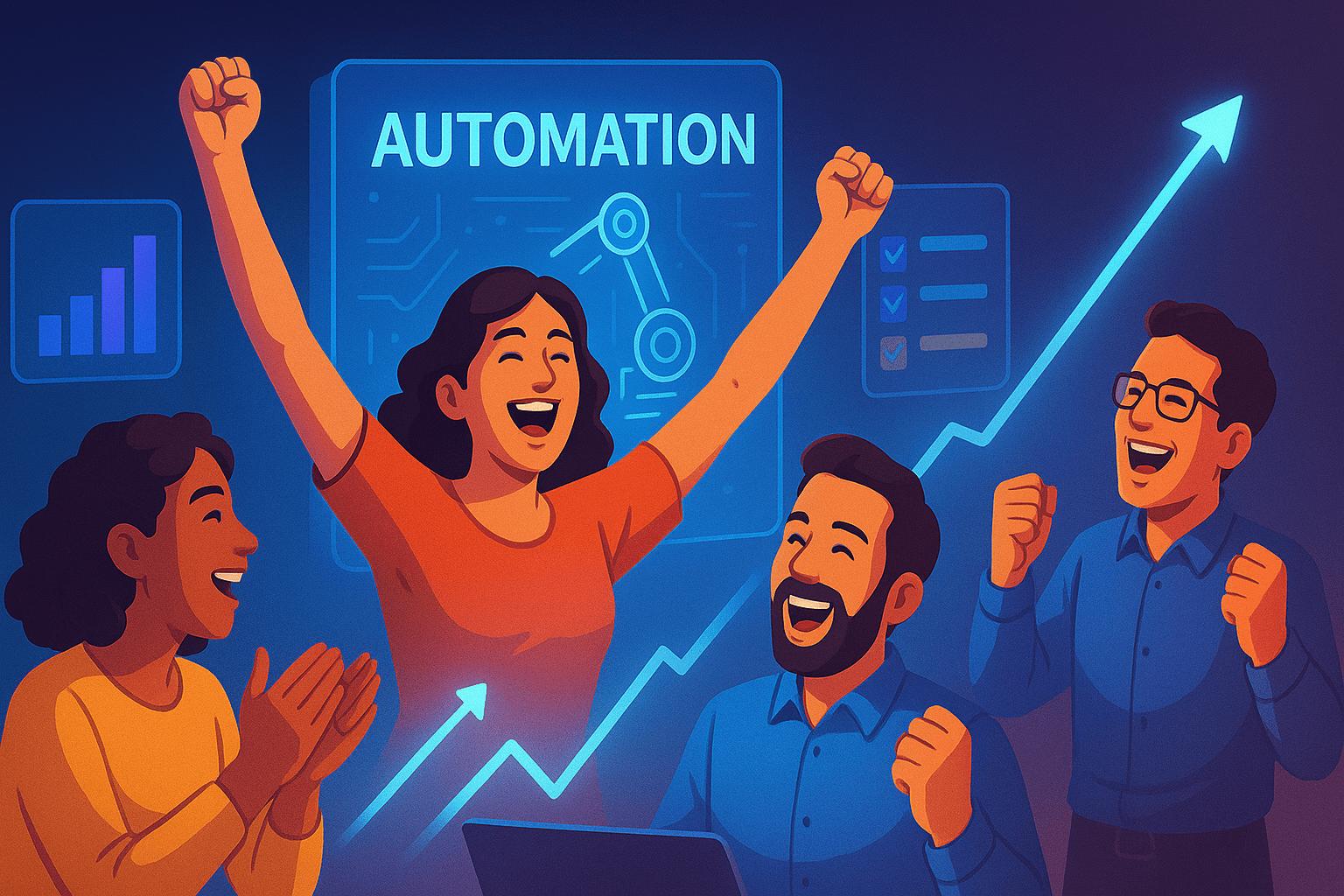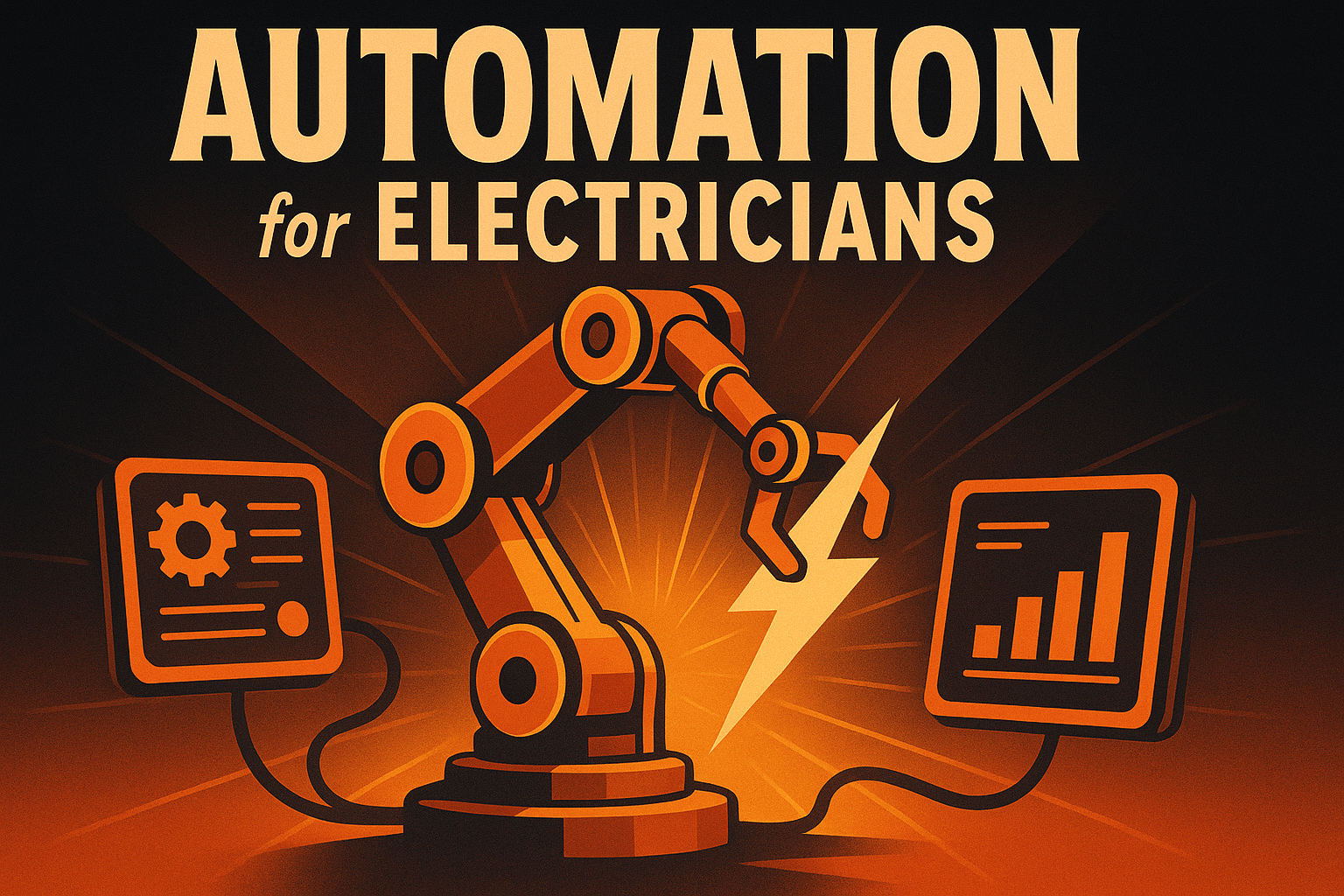Complete Guide to Automation for SaaS & Tech Startups: Scale Smart in 2026
by Design Delulu Editorial · October 13, 2025

In the high-velocity world of SaaS and tech startups, automation isn't a luxury—it's survival. While competitors drown in manual processes and scattered data, smart startups are leveraging automation to scale operations, accelerate growth, and make data-driven decisions at lightning speed. The difference between a startup that stalls at 100 customers and one that scales to 10,000 often comes down to how early and effectively they implement automation infrastructure.
The stakes have never been higher. Investors expect lean operations, customers demand instant responsiveness, and your team needs to focus on innovation—not repetitive tasks. When done right, automation doesn't just save time; it transforms how your entire organization operates, providing the measurement frameworks, workflow efficiency, and scalability foundation that turn promising startups into market leaders. Here's your complete blueprint for implementing automation that actually moves the needle.

Why Automation Is Critical for SaaS & Tech Startup Success
SaaS startups operate in an environment where speed, efficiency, and data accuracy determine survival. Every manual process creates bottlenecks that slow your growth trajectory. Every data gap leaves you flying blind when making million-dollar decisions. Automation solves both problems simultaneously by creating systems that scale infinitely without proportional increases in headcount or overhead.
Consider the typical SaaS startup journey: you're juggling product development, customer acquisition, user onboarding, support, and countless other functions with a lean team. Manual tracking means you're weeks behind understanding what's actually working. Spreadsheet reporting means every stakeholder sees different numbers. Disconnected tools mean critical insights fall through the cracks. Automation eliminates these friction points by creating a single source of truth that updates in real-time, enabling your team to move faster and smarter.
The competitive advantage extends beyond operational efficiency. Automated measurement and attribution systems reveal exactly which marketing channels, product features, and user experiences drive revenue. This clarity enables rapid iteration and optimization—testing, learning, and scaling what works while cutting what doesn't. In fast-moving markets, this feedback loop advantage compounds quickly, separating winners from the pack.
Core Components of Startup Automation Infrastructure
Effective automation for SaaS startups rests on four foundational pillars that work together to create a cohesive, scalable system. Each component serves a specific purpose while integrating seamlessly with the others to deliver comprehensive operational intelligence and efficiency.
Advanced Event and Conversion Tracking
Modern SaaS businesses require granular visibility into every user interaction. Implementing GA4 with enhanced ecommerce tracking and server-side tagging creates a robust foundation for understanding user behavior across your entire funnel. Unlike legacy analytics setups, server-side tracking ensures data accuracy even as browser privacy restrictions tighten, while capturing crucial events that client-side tracking misses—subscription upgrades, feature usage patterns, API calls, and integration activity.
The key is architecting your tracking taxonomy upfront. Define events that map directly to business outcomes: trial starts, activation milestones, expansion triggers, and churn signals. Structure your data layer to capture user properties, account metadata, and contextual information that enables sophisticated segmentation. This foundation supports everything from product analytics to revenue attribution, making it the most critical investment in your automation infrastructure.
Centralized Dashboard and Reporting Systems
Scattered data across multiple platforms creates organizational chaos. Looker Studio dashboards consolidate metrics from GA4, your CRM, product database, and marketing platforms into unified views that everyone trusts. Build role-specific dashboards—executives need high-level KPIs and trends, marketing needs campaign performance and attribution, product needs activation and retention metrics, and sales needs pipeline and conversion data.
The power of centralized dashboards extends beyond convenience. When everyone references the same numbers, decision-making accelerates dramatically. No more days spent reconciling conflicting reports or debating whose data is correct. Real-time updates mean you spot problems and opportunities immediately rather than discovering them weeks later in monthly reviews. This operational cadence advantage alone can accelerate your growth rate significantly.
Multi-Touch Attribution Modeling
SaaS customer journeys are complex, often spanning multiple touchpoints across weeks or months before conversion. Simplistic last-click attribution wildly misrepresents channel effectiveness, leading to misallocated budgets and missed opportunities. Sophisticated attribution modeling reveals the true contribution of each touchpoint—that early blog post that created awareness, the webinar that built trust, the case study that provided social proof, and the demo that closed the deal.
Implement attribution frameworks that align with your specific funnel dynamics. For product-led growth startups, weight early product interactions heavily. For sales-led organizations, give appropriate credit to SDR touchpoints and content that progresses opportunities. Custom attribution models let you test hypotheses about channel effectiveness and optimize spend with confidence rather than guesswork. The insights revealed often contradict conventional wisdom, uncovering hidden growth levers.
Data Governance and Quality Control
Automation only delivers value when your data is clean, consistent, and trustworthy. Implement governance frameworks that enforce naming conventions, validate data integrity, and catch implementation errors before they corrupt your analytics. Create documentation that ensures anyone can understand your tracking taxonomy, and establish review processes that maintain quality as your team and complexity grow.
Strong governance prevents the data decay that plagues most startups as they scale. Without it, tracking degrades over time through inconsistent implementation, undocumented changes, and accumulated technical debt. With proper governance, your automation infrastructure becomes more valuable over time as historical data enables trend analysis, cohort studies, and predictive modeling that guide strategic decisions.

The Proven Implementation Framework
Successful automation implementations follow a structured four-phase methodology that balances speed with thoroughness. This framework has been refined across hundreds of SaaS engagements, consistently delivering measurable results while avoiding the common pitfalls that derail automation projects.
Phase 1: Discovery and Goal Alignment
Every automation initiative begins with clarity about outcomes. What specific business problems are you solving? What decisions will this data enable? What metrics truly matter for your business model and growth stage? This discovery phase maps your current state, identifies gaps, and establishes success criteria that guide all subsequent work.
Effective discovery involves stakeholders across functions—product, marketing, sales, and executive leadership. Each perspective reveals different requirements and constraints. Product needs usage analytics for roadmap prioritization. Marketing needs attribution for budget allocation. Sales needs lead scoring for prioritization. Executives need financial metrics and growth indicators. Documenting these requirements upfront prevents costly rework and ensures your automation delivers value for everyone.
Technical constraints matter equally. What systems currently exist? What integration capabilities do your tools provide? What data security and privacy requirements must you satisfy? What team bandwidth is available for implementation and maintenance? Addressing these practical considerations early ensures your automation design is realistic and sustainable.
Phase 2: Strategic Blueprint Development
With requirements clear, the blueprint phase designs your comprehensive automation architecture. This includes your tracking taxonomy—every event, property, and dimension you'll capture. Your integration map—how data flows between systems. Your dashboard structure—what metrics appear where for whom. Your attribution methodology—how credit distributes across touchpoints.
The blueprint serves as both technical specification and stakeholder alignment tool. It makes abstract concepts concrete, enabling feedback and refinement before implementation begins. This upfront investment prevents the misalignment that plagues projects where teams build first and think later. When everyone agrees on the blueprint, implementation becomes straightforward execution rather than constant negotiation.
Blueprint development also includes measurement planning—defining baselines, setting targets, and establishing the success metrics that determine whether your automation initiative achieved its goals. This accountability framework keeps projects focused on business impact rather than technical features.
Phase 3: Build, QA, and Deployment
Implementation brings your blueprint to life through systematic execution. Configure GA4 properties with custom events and parameters. Implement server-side tagging through Google Tag Manager Server. Build out CRM integrations and data pipelines. Construct dashboards with the metrics and visualizations specified in your blueprint. Set up attribution models in your analytics platform.
Quality assurance is non-negotiable. Every event must fire correctly across devices and scenarios. Every integration must handle edge cases gracefully. Every dashboard must display accurate data. Comprehensive QA catches issues before they corrupt your analytics, saving countless hours of debugging and data reconciliation later. Use a structured testing protocol that validates each component individually and the system holistically.
Deployment should be phased rather than big-bang. Roll out core tracking first, validate accuracy, then layer in advanced features. This incremental approach reduces risk while delivering value quickly. Your team starts benefiting from automation within weeks rather than waiting months for a perfect system that may never materialize.
Phase 4: Optimization and Continuous Improvement
Automation delivers compounding value through ongoing optimization. Monitor your metrics weekly to spot anomalies, opportunities, and emerging trends. Review attribution data monthly to refine your understanding of what drives conversions. Conduct quarterly deep-dives to identify optimization opportunities and expansion possibilities.
The insights revealed through automation should directly inform action. If certain content drives outsized conversions, create more of it. If specific user segments show higher retention, target acquisition toward similar profiles. If particular features correlate with expansion, prioritize their development. This closed-loop process—measure, analyze, act, measure again—accelerates learning and compounds results.
Continuous improvement also means evolving your automation as your business evolves. New products require new tracking. New channels require new attribution. New stakeholders require new dashboards. Treat automation as living infrastructure that grows with your company rather than a one-time project.
Best Practices for Maximum Impact
- Prioritize ruthlessly: Focus on highest-impact pages, flows, and user journeys first. An 80/20 approach delivers most benefits quickly while complex edge cases can follow later. Start with core conversion paths and expand methodically.
- Integrate measurement into creative processes: Every marketing asset, product feature, and user experience should have associated KPIs before launch. This discipline ensures accountability and enables data-driven optimization from day one.
- Build for scale through templates and systems: Create reusable frameworks for common scenarios—campaign tracking templates, dashboard templates, reporting templates. This systematization lets you scale operations without proportional effort increases.
- Establish regular review cadences: Weekly metric reviews keep teams aligned and responsive. Monthly deep-dives enable strategic course corrections. Quarterly retrospectives drive major optimization initiatives. Consistent rhythms prevent reactive firefighting.
- Document everything: Your tracking taxonomy, integration architecture, dashboard logic, and attribution methodology should be thoroughly documented. This knowledge transfer ensures continuity as team members change and enables new team members to contribute quickly.
- Invest in data literacy: The best automation is useless if your team can't interpret data correctly. Train stakeholders on metrics definitions, dashboard navigation, and analysis fundamentals. This capability multiplies automation value across your organization.
SaaS-Specific Automation Strategies
SaaS businesses have unique characteristics that require tailored automation approaches. These industry-specific strategies address the particular challenges and opportunities of subscription-based technology companies.
Mapping Search Intent to Buyer Journey Stages
SaaS buyers progress through distinct stages—problem awareness, solution exploration, vendor evaluation, and purchase decision. Each stage involves different search behaviors and information needs. Automation should track which content pieces serve which stages, then attribute conversions appropriately. Early-stage educational content rarely converts directly but plays crucial awareness roles. Later-stage comparison and pricing content drives decisions. Understanding these dynamics through automated tracking prevents misattribution and budget waste.
Leveraging Social Proof Throughout the Journey
Trust is paramount for SaaS purchases. Automate the measurement of how social proof elements—customer logos, testimonials, case studies, reviews, user counts—impact conversion rates at different journey stages. Track which proof points resonate with which segments. Test placement and messaging systematically. The insights enable optimization that dramatically improves conversion efficiency.
Maintaining a Single Source of Truth
SaaS businesses juggle metrics across product analytics, marketing attribution, sales CRM, financial systems, and customer success platforms. Without automation, reconciling these systems becomes a full-time job that still produces conflicting numbers. Centralized dashboards that integrate across systems create the single source of truth that enables fast, confident decision-making. Everyone references the same metrics, debates focus on strategy rather than data accuracy, and execution accelerates.
Embracing Rapid Iteration Cycles
SaaS businesses can deploy changes instantly—no manufacturing, no distribution, no physical constraints. This velocity is a massive advantage, but only when paired with measurement that provides immediate feedback. Automate experiment tracking so you can ship changes, measure impact within days, and iterate rapidly. This fast-cycle learning compounds into sustainable competitive advantages as you optimize conversion funnels, onboarding experiences, and feature adoption continuously.
Focusing on Leading Indicators
Lagging indicators like MRR and churn are important but react slowly to changes. Leading indicators—trial start rates, activation completion, feature adoption, engagement scores—predict future outcomes and respond quickly to optimizations. Automate tracking and alerting for leading indicators so you spot trends early and intervene proactively rather than reacting to lagging metric declines months later.

Common Pitfalls and How to Avoid Them
Most automation initiatives fail not from technical challenges but from strategic mistakes. Awareness of common pitfalls enables prevention.
Tracking everything without prioritization: Drowning in data is as problematic as data scarcity. Focus on metrics that directly inform decisions rather than capturing everything possible. Start lean and expand based on proven need.
Implementing without stakeholder alignment: Automation that doesn't serve actual stakeholder needs becomes shelfware. Involve users throughout design and implementation to ensure the system delivers what they actually need rather than what technologists think they need.
Neglecting data quality: Garbage in, garbage out applies absolutely to automation. Without robust QA and governance, your automated systems produce misleading insights that drive poor decisions—worse than having no automation at all.
Building static systems: Your business evolves constantly. Automation that can't adapt becomes obsolete quickly. Design for flexibility and plan for ongoing evolution rather than treating automation as a one-time project.
Ignoring privacy and compliance: Data privacy regulations are tightening globally. Automation that violates GDPR, CCPA, or industry-specific regulations creates massive liability. Build compliance into your architecture from day one rather than retrofitting later.
Measuring Automation ROI
Automation represents significant investment—justify it through clear ROI measurement. Track time savings from eliminated manual processes. Measure decision quality improvements from better data. Quantify revenue impact from optimization insights. Calculate opportunity costs of faster execution. Document team satisfaction improvements from reduced drudgery.
Most SaaS startups find automation ROI manifests across multiple dimensions: operational efficiency gains of 20-40% in data-intensive functions, conversion rate improvements of 15-30% from optimization enabled by better measurement, and strategic clarity that prevents costly misallocations of growth investment. The compounding effects typically deliver full payback within 3-6 months, with ongoing returns multiplying thereafter.
Frequently Asked Questions
Let’s level up your SaaS & Tech Startups business
Need services that actually move the needle for SaaS & Tech Startups? See our approach, pricing, and timelines—then book a quick call.
Additional Resources
- Schedule Your Automation Strategy Call
Book a complimentary 30-minute consultation to discuss your startup's unique automation needs. We'll assess your current systems, identify high-impact opportunities, and outline a customized roadmap for implementing automation that accelerates your growth trajectory and operational efficiency.
- View Our SaaS Automation Portfolio
Explore real-world case studies and success stories from SaaS startups that transformed their operations through intelligent automation. See measurable results, implementation timelines, and the specific strategies that drove growth for companies at various stages from seed to Series B and beyond.
- Access Free SaaS Automation Tools
Download our collection of free automation resources including tracking taxonomy templates, dashboard starter kits, attribution model calculators, and implementation checklists. These battle-tested tools help SaaS startups jumpstart their automation initiatives and avoid common pitfalls.
Related Reading

Discover how automation for electricians streamlines scheduling, invoicing, lead tracking, and customer follow-ups to boost revenue and efficiency. Get started today.

Discover how automation streamlines furniture & home decor operations with GA4 tracking, attribution modeling, and data-driven dashboards. Get your 90-day implementation roadmap.
